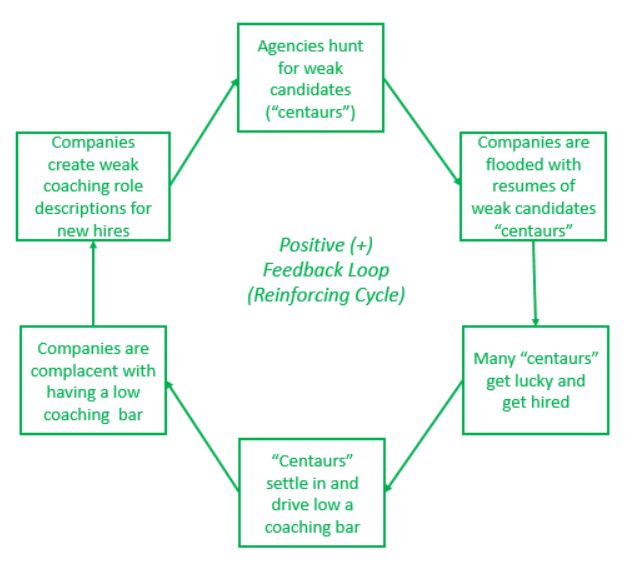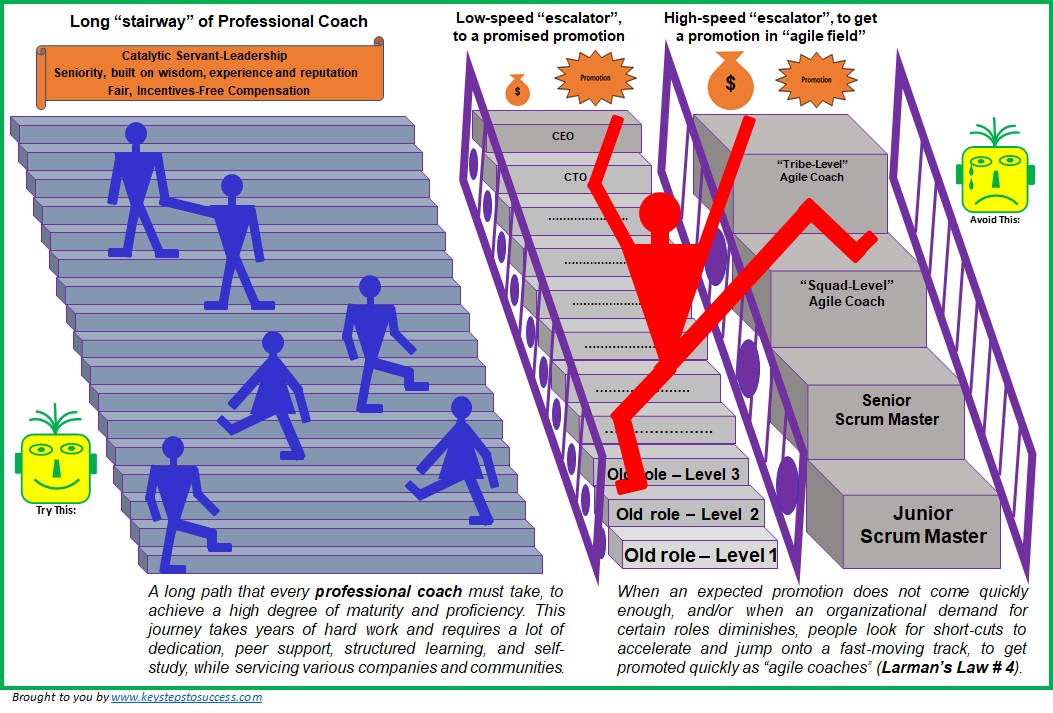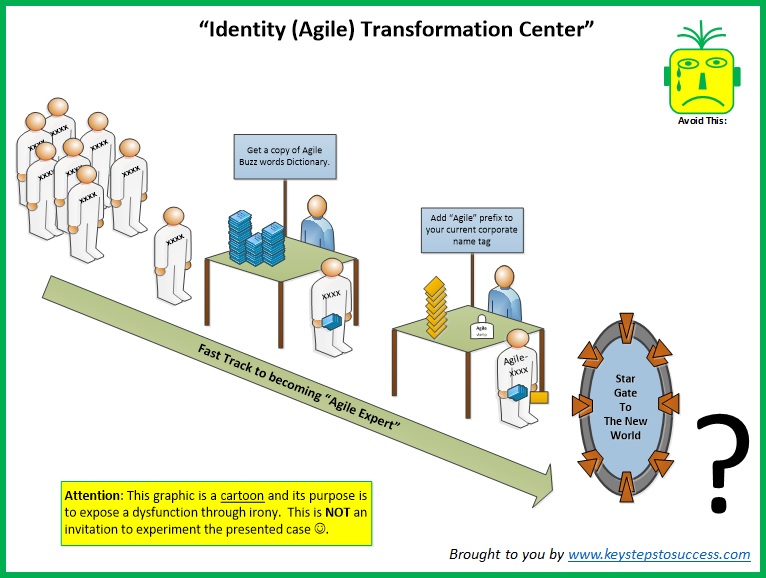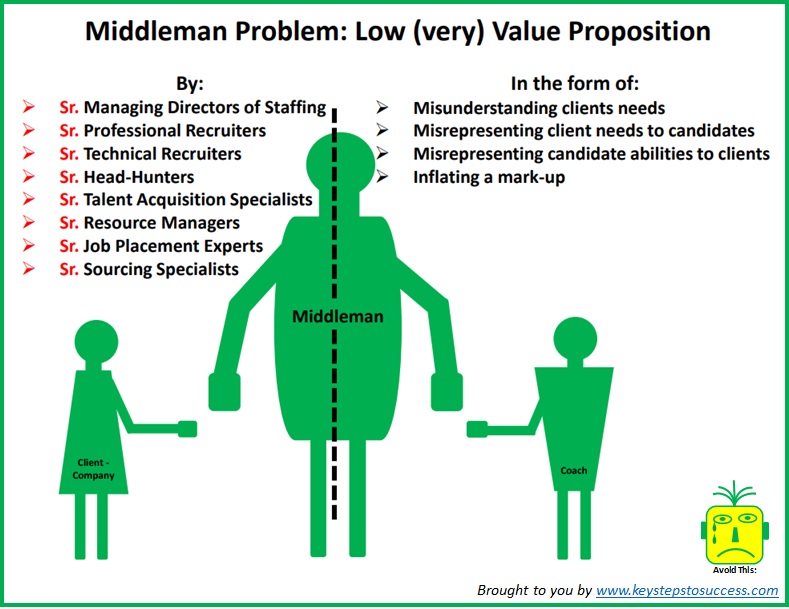If you were a company’s CEO and had a very clear and urgent need to improve your organization, to stay competitive and successful in a marketplace, and therefore, were looking for guide-level senior advisers and coaches, whom you could trust and rely on during your challenging journey, who would you choose: people on the left (blue) or people on the right (red)?
If you further found out that people on the right went through an eager transformation process, as illustrated graphically above, to look-like people on the left, what sentiments would you develop about the situation, based on your learning?
Why are there so many troubled agile “transformations”? We frequently hear the following answer: “because companies lack senior leadership support”. True. And let’s not trivialize this: without strong and genuine support by senior leadership (beyond slogans and “support in spirit”), without selecting a deep, systemic approach to problem resolution, companies can only expect localized, peripheral and, most likely, short-term improvements.
But is there anything/anyone else that can be conveniently held accountable for failed agile transformations?
How about ineffective agile training and coaching? [Note: If you are interested in learning more about some of the most common challenges with agile training, please visit this page. This post is about coaching .]
…There is a vicious cycle that hurts so many companies (can be also considered as a self-inflicted wound):
→initially, companies set a low bar for coaches, based on poor understanding of a coaching role → low quality coaches (quasi-coaches-“centaurs”) are hired, most of whom are not even coaches, but rather people that have mastered agile jargon and know how to impress HR and uninformed hiring managers → weak coaches (most of whom have minds of conformists, not challengers) cannot effectively guide companies to fix systemic weaknesses and dysfunctions → teams and departments don’t really improve; rather create a superficial appearance/illusion of progress (often, to impress senior management) → companies lose faith and stop seeing value in coaching → companies start trivializing a coaching role → companies decide not to spend more money on high quality coaching → cheaper, even less effective, coaches are hired (or internal, misplaced people are refurbished into coaches, overnight, as per Larman’s Law # 4) → initially, low-set coaching bar, is lowered even further…and so on….
Graphically, it looks something like this:

As a result, what was initially meant as a strategic organization- improvement effort, now takes on a form of just another system-gaming change management fad that ultimately leads to a failure and responsibility/blame-shifting.
What are some of the reasons why the above happens? Here are some suggested reasons:
- Companies don’t understand the essence of agile coaching role: it is viewed as another “turn-on switch” management function
- Leadership does not feel a sense of urgency (p. 14) to make changes and exempts itself from being coached: people are too busy and too senior to be coached; they find coaching trivial
- Certain organizational pockets are genuinely resistant to/feared of changes that can be brought about by real coaches (as per Larman’s Laws 1 – 3)
- Spam. Plagiary. Impersonation. – in cyber-space by less-than-reputable entities that want to a piece of agile business.
- Market over-saturation with unskilled recruiters that hunt for low-quality coaches and contribute to the above cycle: this further lowers a company’s chances to find a good coach
This list can be extended….
Who is responsible for initiating this vicious cyclic dysfunction? Does it really matter if we identify guilty ones? Maybe it does, but only, as a lessons-learning exercise. What probably matters more is how to break out of this cycle. Where to start: discontinue low-quality supply (coaches) or raise a bar on demand (by companies)? Usually, demand drives supply and if so, for as long as companies remain complacent and reliant on outlived staffing/head-hunting approaches, cold-calling techniques, and ineffective HR-screening processes, performed by people that poorly understand the essence of an agile coaching profession, while trying to procure cheap “agile” resources or treat seasoned professional coaches, as “requisitions to be filled”, a coaching bar will remain low, and companies will be getting EXACTLY what they have paid for: coaches-centaurs.
Big question
“What should companies be looking for when hiring a coach?”
An organization should be looking much father and beyond of what is typically presented in a resume or a public profile of a candidate: usually, a chronological list of an employment history or a long list of google-able terms & definitions, popular jargon or claims of experience in resolving deep, systemic organizational challenges with Jira configurations ?. Much more attention should be paid to the following important quantitative characteristics of a coach:
Coaching Focus: What is an approach and/or philosophy to coaching does a coach have? This will help a company understand an individual mindset of a coach.
Coaching Education AND Mentorship: What active journey through education, mentorship and collaborative learning in coaching and related activities over significant period has a coach taken?
Formal Coaching Education: What has contributed significantly to a person’s coaching journey, including courses on topics of facilitation, leadership, consulting, coaching, process, and other related activities which have influenced a person’s coaching practice? Such education may not have to be degree-related (training and/or certification from any recognized institution could be sufficient).
Coaching Mentorship & Collaboration: How a coach developed a skill/technique or received guidance to a coaching approach and mindset? Respect and recognition of mentors – matters here.
Informal Coaching Learning: What important topics outside of Agile/Scrum literature have impacted a person’s coaching philosophy? This increases chances that a coach is well-rounded, beyond standardized book learning.
Agile Community Engagement & Leadership: Does a coach engage in agile user groups, gatherings, retreats, camps, conferences, as well as writing, publishing, reviewing, presenting, facilitating, training, mentoring, organizing, and leading agile events? An active participation and leadership in the agile community is a good demonstration that a coach has not developed herself within a unique organizational silo, by self-proclaiming and self-promoting, but rather has diverse and ‘tested’ industry experience.
Agile Community Collaborative Mentoring & Advisory: Does a coach mentor or advise other individuals (not for pay) on how to increase their competency or development? Is a relationship on-going, purposeful and bi-directionally educational?
Coaching Tools, Techniques and Frameworks: Does a coach develop awareness and understanding of tools, techniques and frameworks while engaging with organizations? Has she customized or developed anything that was client/engagement-specific?
In addition to quantitative characteristics , here are qualitative characteristics of a good coach:
Coaching Mindset
- How does a coach react when an outcome of coaching was different from what she had desired? In the past, how did a coach address this situation?
- How, based on clients’ needs, a coaching mindset had to change? In the past, what compromises did a coach make? What was learned?
- What new techniques or skills did a coach learn, to meet a client’s needs?
Coaching Competencies
- Assess – Discovery & Direction
- Balance – Coaching & Consulting
- Catalyze – Leadership & Organizations
- Facilitate – Focus & Alignment
- Educate – Awareness & Understanding
Coaching Specialties
- Lean / Kanban
- User Experience / Design
- Scaling Agile / Enterprise Agility
- Technical / Quality Practices
- Organizational Structures
- Lean Startup
- Product / Portfolio Management
- Organizational Culture
- Learning Organizations
- Non-Software Application
- Business Value / Agility
- Technical / Product Research
- Multi-Team Dynamics
- Organizational Leadership
- Organizational Change
[Note: The above, is based on guidelines provided by Scrum Alliance application process for CTC and CEC.]
While running some risk of sounding self-serving (very much NOT! the intent here) : please, be mindful and responsible when you select guidance-level professionals in your agile journey ?.
Here is a great post with short (under 60 seconds) messages from some highly recognized coaches from the industry, about agile coaching role: So You Want to Become an Agile Coach?




As hunches go, I feel a bit like Columbo asking ‘just one more question’ on top of your excellent blog post. I want to draw your attention to Larman’s Law #1: ‘Organizations are implicitly optimized to avoid changing the status quo middle- and first-level manager and “specialist” positions & power structures.’ – pardon my cynical take but I have anecdotal evidence of “me-too Agile executive” claiming transformation prowess on basis of Org. people size (1000+ people) in record time, gaming conventional metrics (read KPI’s) – and destroying company culture in their wake. They make out like bandits as they get to rake in and hop on to another lucrative quick-fix high profile engagement. IMHO unfortunately this is more prominent in publicly traded big-corps where software is not a direct revenue generator (eg. healthcare) perhaps because final accountability is diffused up the chain of hierarchy.
Really good points made here, Gene! This is exactly one of the challenges we have been seeing around the globe as we travel to lead Agile training for organizations, from CSM to CSPO, Agile Leadership (CAL1), and Agile Marketing. We see companies go through traditional staffing approaches in hopes of bringing a new approach to their organization. One could say this is using the thinking and processes of yesterday to try to get to new levels and ideal future states.
Companies want exponential increase in output and revenue, yet trim down their hiring and training budgets so slim that they compromise on developing their people or bringing the right people in to guide the organization (Coaches to guid the organization and ScrumMasters to guide their teams).
It really is saving just pennies on the hundreds of thousands, then they wonder why they aren’t getting the results without getting the right people or investing properly in their existing people. That’s actually what led me to get behind this initiative of Agile Pro Sourcing that we were talking about recently. Having a company run by a team and leadership that fully understands and lives and breathes the Agile mindset and what companies truly need to be able to achieve all of the glorious results that Agile promises, yet many fall short on.
More details at: http://www.AgileProSourcing.com for those that may be interested in learning more. Thanks again for sharing your insights on this topic, Gene. Very well articulated! The more awareness we create on good Agile practices and sharing our learnings, the more of a difference we can make on real output and results!
Gene,
Your pattern of optimizing on the cost of coaching instead of the value of coaching is one I have seen.
Here is another pattern I have observed: At the start, an organization hires expert coaches. It then decides that agile is ‘working’ and replaces those expert coaches with more and more junior coaches in order to reduce costs. The end result is better than not hiring expert coaches at all but the junior coaches erase much of the gains through their “copy and paste” understanding of agile.
Michael
These are some great points. Thanks for sharing this Gene.
I also usually advise clients to try to find a coach that matches the temperament of the people they will be interacting with. I’ve worked with some coaches who were super pro-active and would always try to intercede before something went wrong. I’ve also worked with some who were super laid back and would always wait until failure had occurred before stepping in, all in the name of helping the team learn. I think there is a fine balance that has to be achieved in terms of creating safety and allowing the team to learn, but allowing them to take reasonable risks so they can gain knowledge. Each org/team is different and will have their own needs, so I think spending some time talking with the potential coach about how the interaction will work before hand, and making sure it is a good fit, is very important.
Totally agree. I tell my clients (and friends) not to engage a coach on the basis of reputation or experience without making sure that the fit is right.
I also tell them that they should require that coaches has some basic training in mental health issues as well. The fact that for most people, work and life issues cannot be kept entirely separate. This is particularly true of people who spend grueling a lot of hours at work. Many of them feel some strain on their personal lives. Not surprisingly, therefore, the more coaches can tap into a their motivation to improve his or her home life, the greater and more lasting the impact of the coaching is likely to be at work.
Hi Miljan,
That’s a very nice insight you’ve included about homelife connection to effectiveness, and thanks for pointing out this holistic dimension of coaching!
Hi Gene,
Boy, you’ve hit the mark with something important here. I’ve been writing (and ranting) for a number of years about these very aspects surrounding agile coaching. I applaud you doing it and support all of your points.
I wanted to share two resources that support / augment your ideas. One is a recent blog post (story) about a coaching engagement that missed the mark. I think you’ll enjoy it – it’s entitled, Agile Coaching – An Awful Truth and you can find it here.
The second resource is a guide I created a couple of years ago that focused on hiring or engaging solid agile coaches. I’ve received so much positive feedback about it over the years that I recently updated it a bit. I think it aligns quite nicely with the characteristics you emphasize. You can find it here.
Keep up the good work Gene!
Hey Gene,
Thanks for raising awareness on the necessary characteristics of an agile coach. As I read your article, I asked myself, “what’s my role in this as an agile coach?”
Certainly, there are issues within organizations that are difficult to overcome and which (left unchecked) can lead to failure. However, we as coaches need to do our part towards improving the situation. You’ve taken a first step by clarifying the quantitative and qualitative characteristics organizations should be looking for when hiring agile coaches. I find that part of my role when engaging with new clients is to have a conversation about what / who an agile does / is, as this is still not well understood.
Additionally, I aim to be clear with my clients on what it is I can and cannot do to help them along in their journey. For example, being clear on what information (if any) from team-level events (retrospectives, agile maturity assessments, etc.) will be shared outside of the team.
I also focus daily on growing in my own coaching mindset, experience and learning while at the same time staying connected to the agile community. This involves participating in events and user groups, writing articles and blogs, and volunteering my time to mentor others. An organization’s journey towards agility is never over; similarly, there is no end to our journey as coaches – we never arrive.
Thanks,
Brock
An interesting article, Gene, highlighting a real challenge.
Something I overheard at the Orlando Scrum Gathering last year keeps reverberating in my head: “Behind every Agile Coach is a failed Scrum implementation.”
The combination of Agile becoming the buzzword de-jour for seemingly every organizational change and coaching being an unregulated industry whereby anyone can call themselves a coach regardless of related knowledge or experience has resulted in a mess of “failed agile implementations”. Unfortunately “failed agile implementations” is nothing new. I wrote about it in 2011 around the time of the 10 year anniversary of the authoring of the Agile Manifesto (reference).
I appreciate your Organizational Agility material referenced in the article include Systems Thinking concepts. I’m of the opinion that the problem here is systemic. To this ends Brock’s comments resonate strongly with me: “What’s my role in this as an agile coach?” I know that you and many others in the Scrum coaching community are working diligently to raise the standard and awareness. It’s certainly a step in the right direction, as would be individuals hiring into these roles considering the quantitative and qualitative guidelines you have outlined. I’m concerned that it still seems like we’re scratching at the surface, however. So I’ll leave with this question that I’ll continue to ponder upon, and invite the coaching community to join me: “What is it that we, the agile coaching community, need to do to instill systemic change?”
Love these points & might even propose that codifying the maturation of an Agile Coach via an ‘apprenticeship’ of sorts – similar to one who would master a trade (electrician, plumber, etc.) could help to distinguish a Master Agile Coach from a Journeyman from a hack. IME, a firm needs a balance of veteran talent and rising stars who can contribute as they gain experience (not unlike a professional sports team from that perspective). Its in the differentiation – aye, there’s the rub.
I would gladly pay a premium for a Master whom could both contribute individually as well as elevate the collective talent around them.
Cheers!
– Jerome